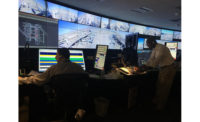A professional central monitoring station is a high-stress environment on a normal day. But when nature takes its turn and unleashes hurricanes, ice storms, lightning, tornados, flash flooding, wild fires or even earthquakes, management has to be prepared for the worst — and to be able bring out the best in employees.
It’s been quite a year for natural disasters, i.e., Hurricanes Harvey, Irma and Maria. Then there were wildfires in California and Colorado and a healthy dose of nor’easters, ice storms and massive swaths of bad weather crisscrossing the country.
But for professional central station monitoring companies, being prepared is their credo and philosophy, as they plan and prepare for storms in the direct path of their operations or events that target their third-party dealer base.
Designing a plan
Having an extensive business continuity plan designed around mission critical processes and disaster recovery is the overall strategy at MONI Smart Security, says Grant Graham, director of Monitoring Operations, Alarm Response Center, Farmers Branch, Texas.
“Monitoring and customer care is critical,” Graham says. “We’re dedicated to having the right processes in place. We track weather in anticipation of rain, ice storms and tornados. If we know there is a storm or inclement weather approaching we inform employees so they have time to come in safely, bring supplies, clothes and other things they may need.” The company also has a contract with two local hotels where it houses emergency response agents and customer care personnel when necessary.
Graham says MONI has also analyzed and devised safe areas of its building in case of an extreme weather event. “We have determined designated safe zones. We have a broadcast system to mass notify employees via cellular or text messages to go to the nearest safe zones. We hunker down for the event.”
SentryNet, with operations in Pensacola, Fla., and Memphis, also follows a documented emergency procedure when a storm threatens its centers, says Alain Jamet, general manager.
“Communication is paramount. We activate a documented emergency procedure that is reviewed, updated and practiced throughout the year. First and foremost, we focus precautionary measures around the safety of employees via continuous updates on advisories and/or evacuations. These updates are provided through three different forms of communication prior to, during and post disaster and consist of the SentryNet emergency hotline (verbal), global email distribution (written) and companywide intranet website through our mobile app. Our Disaster Operating Plan (DOP) guides us through each step.”
He adds that other preparations are ongoing throughout the year, like inventory management of food, water and safety supplies.
Jamet says a contingency schedule is created that emphasizes increased staffing in the facility that is not projected to be impacted, while it maintains minimal staffing with supervision in the facility that may be in the storm’s path. “Our UL central stations are required to meet certain standards to help ensure business continuity and safety. Since our facilities are outfitted with showers and stocked with necessities, the on-shift employees are instructed to bring additional clothing and personal needs. Consistent updates provide clarity to employees as to whether it’s safe to report to, or leave the facility. Every level of management is either on-site or on-call and we encourage employees to contact supervision whenever they are unsure of what to do next.”
Similarly, COPS Monitoring, Williamstown, N.J., shifts its focus to increasing staff at centers that are not in the direct line of the storm to handle an uptick in signals. But it wouldn’t be able to do this if it hadn’t changed its thinking on disaster planning and the facility’s physical infrastructure some years ago.
Expanding with geo diverse locations
“No matter what we tried to do as a stopgap measure for disaster planning it really wasn’t good enough,” says Jim McMullen, president and COO of COPS Monitoring. “The tragic events of 9/11 made it painfully clear that all the preparation in the world fell short if something catastrophic happened to our central station. We felt it was our duty to our dealers and subscribers to have a backup location and we opened our second site in 2004.”
McMullen says it didn’t take long to realize that reliable monitoring relies on more than just a second site and leading technology — it also depends on people. “It’s simple math, really — 50 percent of your staff can’t handle 100 percent of alarm traffic and provide lifesaving response times during an emergency situation. When we opened our third location in Florida in 2006, we found that were able to improve response times during blizzards, hurricanes, and other severe weather by overstaffing our two unaffected sites. It took the pressure off the employees in the affected area and allowed them to focus on their own homes and families.”
COPS Monitoring operates one of the largest hot redundant and active load sharing central stations in the industry with six locations in Williamstown, N.J., (headquarters); Scottsdale, Ariz.; Lewisville, Texas; Boca Raton, Fla; Nashville; and Hunt Valley, Md. “The best way to mitigate risk is to diversify,” McMullen explains.
McMullen adds that this approach has a positive effect on the organization and its ability to handle signals professionally and quickly. “With real-time load sharing, we’re able to attract the best talent from six different locations. No matter what, alarms are delivered to the first available central station operator, with real-time load sharing of incoming signals. There’s no special plan to enact, it’s the way we handle calls 24/7.”
EMERgency 24, Des Plaines, Ill., had a similar epiphany with regard to its physical locations. “Our UL backup was in California,” says Kevin Lehan, Wisconsin branch manager, “and we started to think it wasn’t a good idea. We designed the Wisconsin location as our UL redundant site which is in fairly close proximity. If something catastrophic happens at our headquarters and we need to bring operators on site we can shuttle them daily so they are still getting home. It makes a lot more sense to have your UL backup somewhat close.”
The company also leverages its Incident Command and Communication Software as an early warning mass notification tool for customers. The two-way system effectively enables communications and geo location services. “When we originally developed the software, it was for active shooter notifications, but we keep finding new uses for it,” says Kevin McCarthy, national sales manager. “Users receive emergency notification and use it to communicate, even check in with a Web link to indicate their status during an event. It provides the GPS location of the user. It’s a way to relay information to first responders or others during a disaster.”
In the example of AvantGuard Monitoring Centers, Ogden, Utah, which doesn’t normally experience hurricanes or earthquakes, signals are processed completely in either central station, says Alex Flitton, marketing assistant. “If one goes down, the other facility can take the entire processing load for all signals. And operators can transport to the other facility, which is in driving distance.”
The People Factor
Flitton says the first thing AvantGuard does in advance of a storm is to communicate to all its dealers. “We do this in an email or social media post so they know a storm is coming or a natural disaster is taking place and what our procedures are. We use the Storm Cue option in our monitoring automation software to partition high priority signals. With Storm Cue we can select a geographic area or choose subscribers or a specific dealer to prioritize signals.”
SDM 2017 Dealer of the Year ADT and its Jacksonville, Fla., Customer Monitoring Centers (CMC) orchestrated some innovative employee engagement around Hurricane Irma in September, which necessitated closing its operations for 24 hours.
“First and foremost the safety of the employees is paramount,” says Gary Gersten, ADT’s Jacksonville site director. “We also need to make sure we service customers exceptionally during storm and non-storm times. Some employees went home to be with families and some wanted to stay to the very end. Throughout, we wanted to show our appreciation and that we cared.
“We bought lunch for everyone. We distributed Blue Bucks — ADT dollars that were incentives to buy branded items. When we reopened we brought in breakfast. We really appreciated everything they were doing for our customers. They were going above and beyond not just for ADT but all its customers. We bought everyone tickets to see the Jacksonville Jaguar’s professional football game as a thank you. We gave them time to settle personal things when the storm was over before they came back to work. Our other call centers also accumulated massive amounts of overtime, all to help the customer,” Gersten says.
Handling alarms at any time can be stressful, but especially when subscribers are in flooded homes or other areas impacted by a storm. Not only is strategic planning important, but preparing employees and dealer customers is critical.
“During the flooding in Houston, we had many customers impacted,” says Carolyn Escamilla, director of operations, United Central Control (UCC), San Antonio, Texas. “We had operators who were talking to people sitting on their roofs. What they hear can be upsetting and emotionally draining. So we focus on preparing our employees mentally for distressing situations.” While they were well-prepared for Hurricane Harvey, they served many subscribers, about 75,000 monitored accounts, in the storm-affected area.
UCC has a hotel within walking distance to the center where they reserve rooms during storms or other unusual conditions. If operators prefer to stay in the facility, UCC is stocked with blankets, pillows, air mattresses and toiletries, as well as massive amounts of food.
Mark Matlock, senior vice president of sales, says UCC notifies dealers and provides a checklist on what to do in preparation. “We set the expectation of how signals will be handled for the dealer. Another thing we do is contain the storm response area to a specific group of operators, while another group handles the other areas, so signals in a non-storm area aren’t affected.”
Doyle Security Systems Inc., Rochester, N.Y., takes a proactive approach to informing dealers of the potential consequences of storms.
“We send out email blasts to customers with tips on what to do if they get low battery alerts after an outage, and also have a YouTube tutorial. Instead of having hundreds of calls coming in we pre-empt it with proactive communications,” says Ernie Cole, director of operations for the Emergency Response Center, Doyle Security.
Doyle is a fourth-generation company with 25,000 customers throughout Upstate New York and Northwestern Pennsylvania. The company also brings service technicians in during storms and outages so they can field technical calls from subscribers while operators focus on priority alarms.
“The events that really affect us are wind, lightning, snow and ice storms,” Cole says. “We make sure we have employees on call and ready to come in. We monitor the conditions and have people available to cover shifts. Many of our employees are local and within a few minutes of the central station. One big obstacle is driving conditions. If the city has a ‘no driving’ alert we cancel calls for service technicians. We make sure our parking lots and walkways are cleared for employees and have water, coffee and food in case they have to stay an extended time. An important part of all this is getting them in and getting them home safely after their shift.”
Caroline Brown, vice president, Security Central, Statesville, N.C., says the monitoring operations maintains a Storm Team for its central station operations.
“We keep service at the highest possible level,” Brown explains. “We have operators on standby and they are directed to come in when there are many accounts in an affected area. We notify our dealer base about potential power losses. We set up a system for our employees who live over a 10-mile radius and put them in a local hotel and run transportation shuttles. We have everyone on 12-hour schedules to keep it simple and make it easy for them to get here safely.”
Security Central’s supervisors monitor satellite feeds to stay apprised of weather conditions. “Signals are handled as planned and there’s no change in the level of service,” she says. “No matter what it is happening on our end, customers still get that same high-level professional monitoring experience.”
The key to effectively managing disasters is setting and managing expectations, says Morgan Hertel, vice president of technology and innovation, Rapid Response Monitoring Services (RRMS), Syracuse, N.Y. “In the case of the recent devastating hurricanes, dealers were made aware that police departments were not responding to alarms. With this in mind, dealers could alter their action plans to better service their customers and we were able to focus on handling the surge in intrusion alarms and effectively notify subscribers of events they needed to be aware of.”
Hertel says every employee spends months learning all aspects of providing high-quality monitoring service. “This level of training allows us to instantly reallocate non-monitoring personnel to help out in the monitoring center when necessary. We also have an advanced Nuance-based IVR platform that can make hundreds of simultaneous calls to affected areas and interact with subscribers using natural language speech recognition. These two resources combined have the effect of instantly adding 500-plus staff members to the monitoring center to respond to activity from the affected areas. Of course this is in addition to all of the SMS, push notifications and emails that automatically go out as part of standard operating procedure.”
When Things Go Wrong
Nothing is 100 percent guaranteed and sometimes things may go awry at the central monitoring station. What happens if a call gets dropped resulting in injury or theft or there is an issue and the monitoring center has to face the news media? How do central stations perform internal damage control?
“We always do an investigation before we give the customer information. We send a technician, investigate and report back to the customer. If there is any kind of liability issue we run it through our executive team and get our attorney involved. We always have valid contracts; it’s extremely important.” — Ernie Cole, Doyle Security Systems.
“That’s a tough question. One thing for us, because it’s so core to our values, is to try to be as transparent as possible and not be negative.” — Caroline H. Brown, Security Central.
“You tell the truth and what happened and let the chips fall where they may, and present what you are going to do in the future to make it right. We have a reputation — our dealers tell us we have always stepped up to the plate and they trust us.” — Mark Matlock, UCC.
“Although we’d like to say this can’t happen, operators are human and the potential is there. We have strict guidelines regarding communications and standard internal investigative procedures, along with ongoing training to mitigate possibilities of reoccurrence.” — Alain Jamet, SentryNet.
“It’s important to always be truthful and respond quickly. Keeping people informed on a regular basis is vital. Even an update relaying that nothing has changed is better than leaving dealers in the dark and uninformed. Mistakes can occur and even the best equipment can break; things can also happen in the global and national networks that cause problems.”—Morgan Hertel, Rapid Response Monitoring Services (RRMS).
For more about monitoring in the industry, visit the following articles
Security Companies Roll Up Their Sleeves, Lend Aid After Hurricane HarveyHow Choosing the Right Monitoring Company Reflects Business
The Making of a Central Station
SDM Guide to Monitoring Services
Excellence Award Winners Share Prolific Industry Experience








